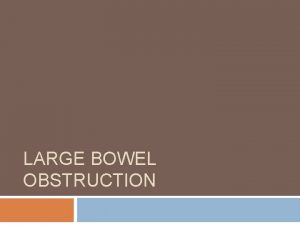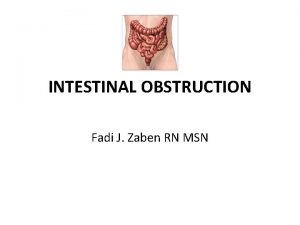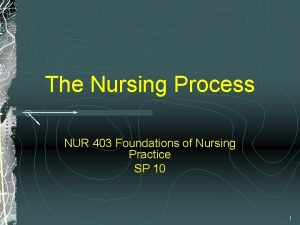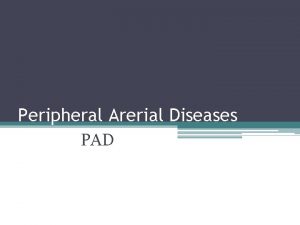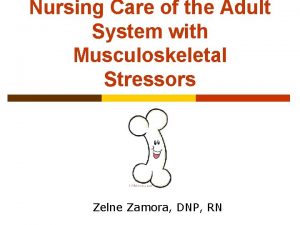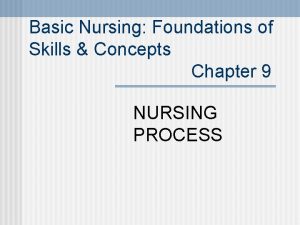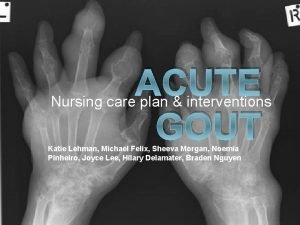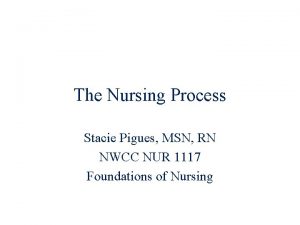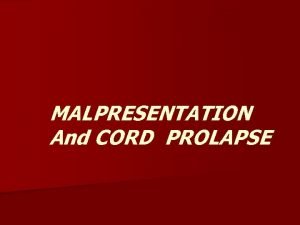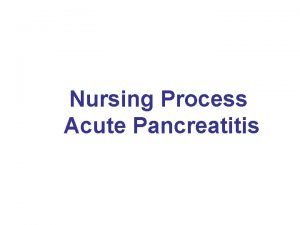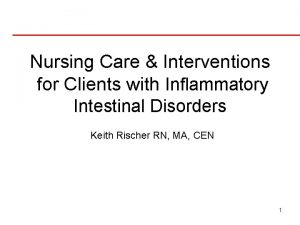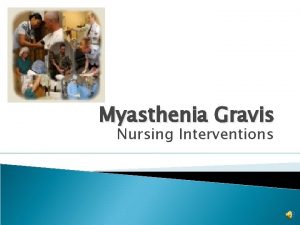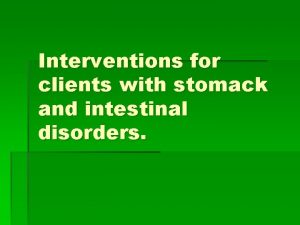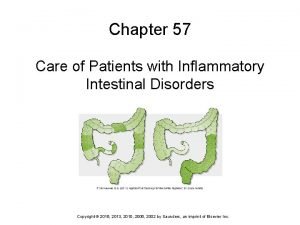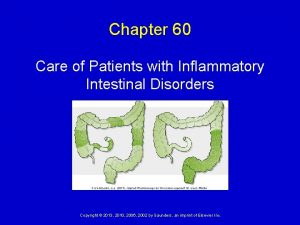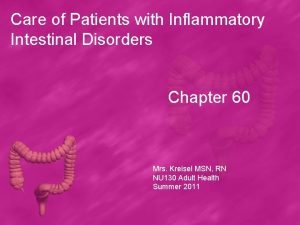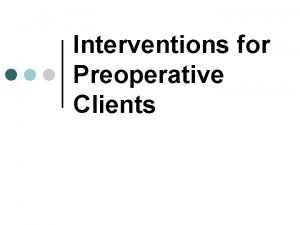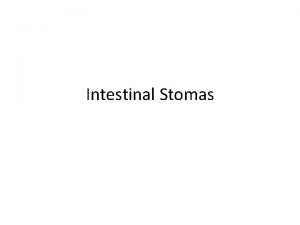Nursing Care Interventions for Clients with Inflammatory Intestinal





















- Slides: 21

Nursing Care & Interventions for Clients with Inflammatory Intestinal Disorders Keith Rischer RN, MA, CEN 1

Today’s Objectives… Ø Ø Ø Describe commonalities in diseases of the gastrointestinal tract. Compare indicators for malignancy throughout the gastro-intestinal system. Discuss relevance of diagnostic test results to the nursing plan of care. Discuss the pathophysiology and assessment findings of ulcerative colitis and Crohn’s disease. Consider nursing interventions for a client with a new ostomy. Develop a teaching plan for a client integrating the use of medication and diet. 2

Chronic Inflammatory Bowel Disease ØUlcerative colitis is one of a group of bowel diseases of unknown etiology characterized by remissions and exacerbations (flare-ups). ØMucosal lining of the colon or rectum is affected. ØLoose stools containing blood and mucus, poor absorption of vital nutrients, and thickening of the colon wall can result. 3

Assessment ØPhysical assessment ØClinical manifestations ØPsychosocial assessment ØLaboratory assessment ØRadiographic assessment 4

Diarrhea Ø Interventions: • • • Record the color, volume, frequency, and consistency of stools. Identify factors that cause or contribute to diarrhea. Eliminate gasproducing and spicy foods. 5

Diarrhea (Continued) • • • Eliminate by trial foods containing lactose. Eat a low-fiber, high-protein, high-calorie diet. Use antidiarrheal medications. Monitor skin. Record weight regularly. Rest the bowel. 6

Drug Therapy ØSalicylate compounds ØCorticosteroids ØImmunosuppressive drugs ØAntidiarrheal drugs ØOther drugs 7

Total Colectomy with a Continent (Kock’s) Ileostomy ØInternal ileal reservoir ØIntra-abdominal pouch created from the terminal ileum by the surgeon ØStool stored in the pouch drained by catheter ØCare of pouch ØEffluent, or drainage, monitored 8

Total Colectomy with Ileoanal Anastomosis (J Pouch) ØRemoval of the colon and the rectum with the ileum sutured into the anal canal ØSpares the rectal sphincter and need for an ostomy ØPreoperative care ØOperative procedure ØPostoperative care 9

Acute Pain; Chronic Pain ØInterventions include: • Pain management in ulcerative colitis üComprehensive pain assessment üEvaluation of effectiveness of pain control measures used üReduction or elimination of precipitating factors for pain. üTeach use of non- 10

Potential for Gastrointestinal Bleeding ØInterventions • • • include: Monitoring for signs and symptoms of gastrointestinal bleeding Monitoring all stools for blood, using both gross and occult examination Monitoring hematocrit, hemoglobin, and electrolyte values Monitoring vital signs Preparing for possible blood administration 11

Crohn’s Disease ØIdiopathic inflammatory disease of the small intestine and the colon, or both ØAll layers of the bowel involved, mostly terminal ileum ØBowel fistulas ØRare cancer of the small bowel and colon develop. ØMalabsorption of vitamins and nutrients 12

Assessment ØPhysical assessment ØClinical manifestations ØPsychosocial assessment ØDiagnostic assessment 13

Nonsurgical Management ØDrug therapy ØNutritional management ØComplication management ØFluid and electrolyte therapy ØSkin care ØPrevention of infection ØComplementary and alternative therapy 14

Surgical Management ØLaparoscopy ØSmall bowel resection and ileocecal resections ØStricturoplasty ØPreoperative care ØOperative procedure ØPostoperative care 15

Diverticular Disease ØDiverticulosis is the presence of many abnormal pouchlike herniations in the wall of the intestine. ØDiverticulitis is the term used to describe an inflammation of one or more of the diverticula. 16

Assessments ØHistory ØPhysical assessment ØClinical manifestations ØDiagnostic assessment 17

Nonsurgical Management ØDrug therapy ØDiet therapy ØRest ØIntravenous fluids to correct dehydration ØIntravenous antibiotics ØAnticholinergics ØAnalgesics ( 18

Nonsurgical Management ØAvoid laxatives ØRest ØNothing by mouth in the hospital 19

Surgical Management Ø Preoperative care Ø Operative procedure Ø Postoperative care • Drain care • Care of the ostomy • Nothing by mouth followed by clear liquids 20

Anorectal Abscess ØLocalized induration and fluctuance due to the inflammation of the soft tissue near the rectum or anus ØRectal pain first symptom ØSurgical incision and drainage ØNursing interventions focused on helping the client maintain comfort and optimal perineal hygiene ØHigh-fiber diet 21
 Dynamic obstruction intestine
Dynamic obstruction intestine Nursing diagnosis for intestinal obstruction
Nursing diagnosis for intestinal obstruction Planning in nursing process
Planning in nursing process Evaluation in nursing process
Evaluation in nursing process Collaborative interventions nursing
Collaborative interventions nursing As evidenced by nursing examples
As evidenced by nursing examples Nursing interventions for dvt
Nursing interventions for dvt Dependent intervention nursing
Dependent intervention nursing Ineffective childbearing process example
Ineffective childbearing process example Goals and expected outcomes
Goals and expected outcomes Rheumatoid arthritis nursing interventions
Rheumatoid arthritis nursing interventions Nursing management of thyrotoxicosis
Nursing management of thyrotoxicosis Skeletal traction vs skin traction
Skeletal traction vs skin traction Nursing diagnosis for panic disorder
Nursing diagnosis for panic disorder Obsessive compulsive disorder nursing management
Obsessive compulsive disorder nursing management Collaborative nursing interventions
Collaborative nursing interventions Dependent nursing interventions
Dependent nursing interventions Nursing diagnosis for gout
Nursing diagnosis for gout Independent nursing interventions
Independent nursing interventions Left sacroanterior position
Left sacroanterior position Pancreatitis nursing assessment
Pancreatitis nursing assessment Poor skin turgor nursing diagnosis
Poor skin turgor nursing diagnosis
